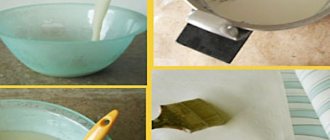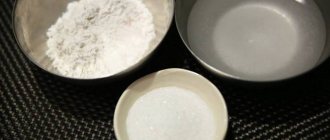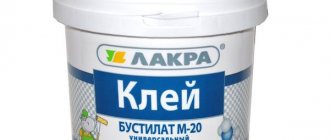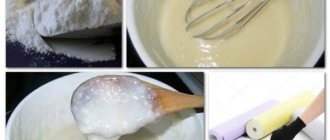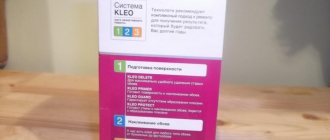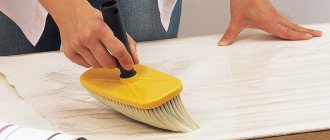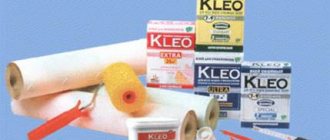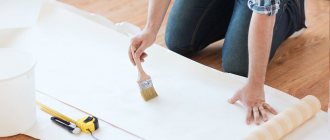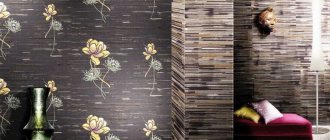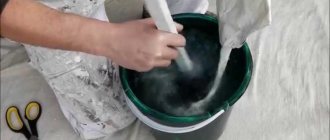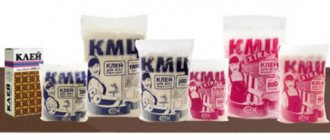Which wallpapers are covered by GOST?
GOST 6810-2002 applies to borders, friezes and the following types of wallpaper:
- paper;
- non-woven;
- textile on paper or non-woven basis;
- vinyl on paper or non-woven base.
Wallpaper made from textile materials without a paper backing, fiberglass or photo wallpaper must comply with other regulatory documents.
All wallpaper sold in Russia must comply with the requirements of GOST 6810-2002
How to choose wallpaper glue ↑
When hiring a team of professional finishers, we fully rely on their experience and knowledge, as well as on the recommendations of relatives and friends. As a result, we most often get beautiful, smooth walls, without flaws, bubbles or wrinkles. Do-it-yourself repairs are a completely different matter. Here you have to decide everything yourself: from choosing rolls to purchasing brushes, rollers and buckets.
Beautiful wallpaper - an opportunity to highlight your style
We encounter the first difficulties when we find ourselves in front of endless shelves with various types of building materials, and many questions immediately arise: which adhesive is better for paper, vinyl or non-woven wallpaper, whether it is possible to save money on its purchase, how expensive offers differ from cheap ones. We warn you right away: it is better not to experiment and stick to high-quality products from well-known manufacturers that have proven themselves exclusively on the positive side.
What are the dangers of using economy class materials or using homemade paste? The consequences can be unpleasant: peeling of the cladding along the joints or in whole pieces, changing the color of the decor, the appearance of stains and streaks on the front wall. Remodeling is a long and labor-intensive task, so saving in this case means buying expensive material.
High-quality glue is the key to a comfortable life without repairs
Thus, if you have started a serious renovation, you should only purchase high-quality products from companies that have been developing and improving them for decades. Don’t forget that special glue is now produced for each category of wallpaper - more on that later.
Types and decorative designs of wallpaper
Depending on the manufacturing features, paper and vinyl wallpapers are divided into several types:
- Embossed ones have a relief surface. To do this, during the manufacturing process they are subjected to chemical, hot, wet or dry embossing. Such wallpaper can have a paper or non-woven backing.
- Profile wallpaper also has a relief surface in the form of a three-dimensional pattern. They are most often made by embossing.
- Velor wallpaper has a fleecy surface. They are made on a paper or non-woven basis, and the characteristic relief is formed with a pile covering.
- Metallized wallpaper is a new generation of finishing materials. They are made on a paper or non-woven basis, and the top layer is aluminum foil or film. Next, the material is embossed, dyed, patinated, blackened or etched with chemical compounds to create a pattern.
- Wallpaper for finishing is made on a paper or non-woven basis; they are intended for painting after pasting.
- Wallpaper decorated with natural substances or textile threads differs from other types of finishing materials. During their manufacture, elements made of organic or inorganic substances are fixed on the front side of the material. This could be, for example, grass, cork, etc.
Based on their decorative design, wallpapers are divided into three types:
- With a printed design without a background.
- With printed design and background.
- With a background without a printed pattern.
The presented division into types is not rigid. Wallpaper can be a combination of the listed types and have other decorative designs, but their quality must meet the requirements of GOST 6810-2002.
Glue properties and composition
The adhesive dry mixture is loose white shavings. "Kelid" consists of:
- Cellulose additives that provide excellent adhesive properties and the desired consistency of the finished composition.
- Ecologically safe insecticides for humans and pets, bactericidal components and fungicides that prevent mold and fungi from developing in the space between the wallpaper and the wall. The antiseptic properties of "Kelida" are especially important if the walls are covered with non-woven canvases or vinyl canvases, which do not allow air to pass through well.
- The main component is modified starch or chalk. Mixtures with chalk additives are intended for vinyl wallpapers because they are heavier than paper ones.
On a note! Quelyd is recommended for use at temperatures from +5 to +25 degrees. If the room is too hot, the time for using the finished mixture is reduced, and problems may arise when gluing the canvases.
Closed bags of dry glue are stored for the period indicated on the packaging, and the finished composition retains its properties for more than 7 days. The liquid substance must be stored in an airtight container.
The price of the Kelid adhesive composition depends on what kind of paintings it is intended for gluing. The heavier the roll, the more expensive the product. But even the Quelyd mixture for paper wallpaper occupies the middle price segment in the domestic building materials market.
Brands and scope of wallpaper
Based on the resistance of the front side to abrasion and operating characteristics, wallpaper is divided into six classes:
- B-0 – they are water resistant when glued. Undried glue can be removed from their surface during the gluing process with a damp cloth or sponge.
- B-1 – are water resistant during operation. Such wallpaper can be washed with a damp sponge without using detergents.
- M-1 – are resistant to washing. Wallpaper of this brand can be washed using a two percent solution of laundry soap. After this, some types of water-soluble household stains are removed from their surface, but not fats or oils.
- M-2 – highly resistant to washing. They can also be washed using a two percent solution of laundry soap. This removes most water-soluble household stains, including some grease stains.
- M-3 – are resistant to friction. Such wallpaper can be washed using a two percent solution of laundry soap or a cleaning product without bleach. From their surface you can remove not only oils and fats, but also some water-insoluble stains.
- C – resistant to dry abrasion. Such wallpapers are characterized by increased wear resistance.
Taking into account the listed features of wallpaper, GOST 6810-2002 recommends using it for the following purposes:
- M-3 – for toilets and bathrooms of buildings of any type;
- M-1, M-2 – for hallways and inter-apartment corridors of public and residential buildings;
- M-1, B-1, B-0 and C - for any premises of public and residential buildings.
Principles of working with glue
This wallpaper glue sets well. Read its composition. Drop the powder into the water and mix thoroughly. Use glue only after 3 hours, not earlier. Its consumption is moderate and it is relatively cheap. A pack costs around a hundred rubles, minimum 50.
If you purchase a 0.5 kg package, it can be used to cover an area of 50 m². This glue will work on any type of wallpaper. If you purchased thin sheets, then 0.5 kg requires 8 liters of water. If they are dense, then a thicker consistency is needed. For 0.5 kg, take 7 liters of water.
Sometimes you can find the composition packaged in boxes
Dilute this wallpaper glue in warm water until it swells. This takes a minimum of 3 and a maximum of 8 hours, as stated on the packaging. For newer adhesives of this brand, 2 hours is enough.
If you think about it sensibly, it is best to mix it and leave it to swell from evening until morning. And in the morning, when you have rested, start wallpapering the room.
This wallpaper composition will perfectly glue the canvases to the wall. You won’t be able to remove them as easily during your next renovation as wallpaper attached to other compounds.
Dimensions of wallpaper, borders and friezes
The dimensions and permissible deviations of wallpaper, borders and friezes can be as follows:
| Parameter | Limit value | Tolerance |
| Wallpaper | ||
| Roll length | Not less than 10.05 m | – 1,5 % |
| Maximum blade length | No more than 42 m | – |
| Usable width | 530 mm | ± 2 mm |
| Edge width on each side of the fabric | 15 mm | ± 1 mm |
| Friezes | ||
| Roll length | Not less than 10.05 m | – 1,5 % |
| Usable width | Not less than 240 mm | ± 2 mm |
| Curbs | ||
| Length of web in roll or strip | At least 5 m | – 1,5 % |
| Usable width | Not less than 12 mm | ± 2 mm |
By agreement with the consumer, it is possible to produce wallpaper with a usable width of 470, 500 or 750 mm.
A mandatory requirement for wallpaper is that its edges must be parallel and straight.
Description
CMC glue is a product based on the sodium salt of carboxymethylcellulose, obtained by processing cotton cellulose and intended for the preparation of adhesive compositions. It is a finely granulated white powder (the presence of fibers is allowed), containing antiseptic and antifungal additives (borax, hydroxybenzene, potassium aluminum sulfate).
CMC glue is actively used for gluing paper and textile wallpaper, used as an additive in primer, putty, and painting mixtures, and is sometimes present in the component composition of bricks. The adhesive solution has high adhesion to wooden, plastered, concrete surfaces and ensures reliable connection of the material to walls, ceilings, etc.
Requirements for materials, production and quality of wallpaper
GOST 6810-2002 lays down the requirements for the raw materials used for the manufacture of wallpaper, the appearance of the finished finishing materials, the designation of the edge cutting line, winding in rolls and packaging.
The quality of wallpaper should be controlled according to the following indicators:
- color fastness to light;
- wallpaper resistance to abrasion;
- the magnitude of the destructive force in a wet state;
- white (for smooth wallpaper with a white background, intended for pasting ceilings);
- stability of the embossing relief (for two-layer paper wallpaper);
- ability to release harmful substances.
GOST 6810-2002 specifies permissible wallpaper defects:
| Type of defect | Tolerance |
| Presence of spots, stripes and contrasting inclusions | Not allowed on the front side |
| Offset drawing elements | No more than 1 mm (for wallpaper made using letterpress printing - no more than 2 mm) |
| Mismatch of the contour of the pattern with the relief of its embossing for embossed wallpaper | No more than 1.5 mm |
| Presence of smudges, stains or unprinted areas of the design | Allowed size 1.5–2.0 mm in greatest dimension |
| The number of smudges, stains or unprinted areas of the design per 1 m of canvas length | No more than 5 pcs. |
| Presence of mechanical damage, tears, folds, wrinkles | Not allowed |
| Non-parallelism of the edges of the canvas | Not allowed |
| The presence of non-glued areas for two-layer paper wallpaper | Not allowed |
| Bonding adjacent layers in a roll | Not allowed |
| Formation of web rolls from component parts | Not allowed |
Types of CMC glue
Different types have their own application characteristics.
- KMC-1 “Shavings” - used for gluing light, washable wallpaper with a paper base.
- KMC-1 - suitable for light paper wallpaper.
- KMC-N - for gluing lightweight wallpaper with a textile or paper base, considered more economical.
- KMC "Extra Fast" - suitable for gluing wallpaper to concrete and plastered surfaces. Can be used as a primer to prepare walls for gluing.
- KMC-N “Super-Max” - suitable for all paper wallpapers on concrete and plastered walls.
- KMC-N “Mini-Max” is an adhesive for light, washable and regular paper wallpaper.
There is also CMC with the addition of PVA.
This glue is suitable for paper and textile-based wallpaper and paper, it can stick them well to concrete, wood, plastered and other non-metallic surfaces, except painted ones - it doesn’t stick well to them, and it is better to choose a glue based on methylcellulose containing PVA (polyvinyl acetate ), which increases the adhesive ability. Watch a video about different types of wallpaper paste:
This glue is also available with a color indicator, thanks to which you can clearly see which part of the wallpaper it has already been applied to. As it dries, it becomes colorless.
- Liquid glass and its application
- How many boards in a cube
- Fiberboard or hardboard
- DIY bark beetle plaster
- Appearance
- Principles of working with glue
- Specifications
- Technical data
Have you decided to start renovations at home, change the wallpaper, but the variety and large assortment of adhesives in the supermarket make your eyes widen? Remember what composition was applied to the wallpaper that is now hanging in your rooms 5 or 10 years ago. For many, this will be the well-known CMC.
Non-standard packaging of the composition, 1 kg
Do you think it has disappeared from the building materials market, the manufacturers have been crushed by competitors of more expensive and high-quality imported goods? Nothing like this. Go to the nearest large construction supermarket and ask about CMC glue. Sellers will show you a wide range of them. Choose.
Labeling requirements
GOST 6810-2002 requires that markings be present on the label of each roll of wallpaper, borders or friezes. It must contain information about the manufacturer, classification, batch and date of manufacture, dimensions, scope of application, characteristics and brief instructions for using the finishing material. Additional information may be included in the labeling. A separate appendix lists the graphic symbols that are used on the label to indicate the properties of the wallpaper.
Wallpaper is marked with these graphic symbols
Application
In general, the instructions for using wallpaper glue are not particularly complicated: strips of wallpaper are coated with it, pressed against the wall and smoothed out.
A number of nuances, however, are useful to know in this case.
- When gluing non-woven fabric, the glue is applied only to the wall.
- If the wallpaper is heavy, it is better to coat both the canvas and the wall with glue. Excess squeezed out at the seams is immediately removed with a sponge.
- Adding 500 grams of PVA per bucket of finished adhesive composition will increase its water resistance and adhesive qualities.
- Wallpaper on a paper backing requires quite a long time to soak it. After you have applied the glue, the strip is folded in half (this operation will prevent the glue from drying) and left for 10-15 minutes.
- Adhesive compositions are successfully used for preliminary priming of walls. In this case, they are diluted to a more liquid consistency.
Before wallpapering, the walls must be primed. On solid substrates you can use liquid wallpaper glue.
Recommendations and useful tips
Experts suggest following these tips when performing work:
- Work only on clean surfaces, free from dirt and dust.
- Take precautions when using glue. Substance that gets into the eye may cause irritation. In this case, rinse your eye with clean water for 15 minutes. Afterwards, be sure to go to an ophthalmologist for professional advice. In the future, use eye protection.
Eye irritation
- To remove traces of glue from the surface of the leather, use solvent or white spirit.
Manufacturers
In Russia, CMC is produced by the Polycell, Omega, Karbotsel, and Malva factories. Glue from these manufacturers is cheap.
Foreign manufacturers of CMC glue include:
- Cleo is a French glue that costs 250 rubles per 0.5 kg. Contains fungicidal additives and leaves no residue.
2. Kelid - again a French composition, which began to be actively counterfeited, which is noticeable by the increased consumption of material. The company takes steps to prevent this by regularly changing its packaging design.
3. Methylane - produced in Germany, the company produces a full range of wallpaper adhesives, there are different types and a choice of packaging weights.
It is better to choose CMC glue specifically for wallpapering. It receives good reviews and continues to be popular among craftsmen. It is important not to fall for a fake and choose the right product for specific purposes.
Source (full version): https://gidpokraske.ru/tovary-i-brendy/klej-kmts.html
4Classification
4.1 Adhesives, depending on the type of floor covering being glued, are divided into adhesives for: PVC, natural linoleum, textile coverings, rubber coverings, parquet.
The adhesive can be used for one or more types of floor coverings according to the recommendations of both floor coverings and adhesives manufacturers.
4.2 The symbol of the adhesive consists of the name of the classification characteristics (purpose) and the designation of this standard.
Example of product designation when ordering and in other documentation:
— Glue for PVC coating,
GOST R 58211-2018
.
— Glue for natural linoleum,
GOST R58211-2018
.
— Adhesive for textile covering,
GOST R 58211-2018
.
— Glue for rubber coating,
GOST R58211-2018
.
— Glue for parquet,
GOST R 58211-2018
.
Main characteristics
There may be different manufacturers of glue, but the average technical parameters of the finished product are respected by everyone. The most important characteristics of the glue:
- the share of the main dry matter in the composition is 57%;
- the share of the active substance in relation to the total amount of dry matter is 6%;
- the proportion of sodium chloride from the total amount of dry matter is 21%;
- the proportion of moisture in the glue is 12%;
- degree of substitution of carboxymethyl groups – 65-85;
- solubility – 96% (minimum);
- pH of 1.5% aqueous solution – 8-11;
- shelf life of the 4% solution is 7 days;
- the time for swelling of the mass to homogeneity is up to 2 hours.
Peculiarities
First of all, it is worth emphasizing that there is not just one “Moment” glue; it is a whole galaxy of connecting materials, each intended for a specific task.
Regardless of the specific scope of application, they differ:
- long period of work;
- immunity to water ingress;
- excellent resistance to overheating;
- mechanical strength;
- stability of the formed adhesive seam.
When the adhesive hardens, it does not expand or shrink (which are the main reasons why joints fail prematurely). Even when solvent or machine oil gets into the connection, the performance characteristics are completely preserved. Adhesion between surfaces occurs very quickly, there is no need to take a break from your usual daily activities for a long time.
But its high qualities and associated popularity made Moment a constant target for counterfeiters. No one can guarantee the quality of their products.
As for the unpleasant odor, this is an inevitable feature of almost any adhesive mixture, so there is nothing specific about it.
Diversity of the “Moments” line
Nowadays, the Moment brand produces a wide variety of adhesives designed for any household needs - universal adhesives, adhesives for rubber, wood, wallpaper, mounting, epoxy adhesives, and in addition - polyurethane foam and sealants. The product line of the Moment trademark includes more than 3,000 different types of glue and is produced in more than 80 countries around the world. Of course, the most popular is the Moment universal glue, which allows you to glue various materials with high quality, easily and quickly. And specialized adhesives for specific surfaces to be bonded (rubber, wood, glass) are widely used by specialists in the corresponding profiles. Accordingly, the product line of Moment adhesives is selected depending on the needs: for non-professionals, glue is offered in small containers that do not require special skills when using, and for specialists, the packaging may be larger, the characteristics and approach to use may be different. The main types of glue “Moment” presented on our market are contact, wallpaper, mounting, epoxy, second, universal adhesives, as well as self-adhesive tape, sealants and polyurethane foam. Contact adhesives are represented by the following products: “Moment-1” - universal household adhesive; “Moment” Crystal" - a transparent adhesive that does not leave visible traces of bonding; "Moment Marathon", used for shoes; "Moment Rubber" for all types of rubber products; "Moment Gel" (transparent adhesive gel used for vertical surfaces); "Moment Arctic" ” and “Traffic Moment.” This group of adhesives is used by applying them to the surfaces to be glued and fixing them, and requires a longer time for gluing compared to second adhesives. Second adhesives are presented in five types: “Super Moment”, “Super Moment Gel”, “Super Moment Profi”, “Super Moment Pro Plus”, which differ in the purposes of their use. For example, “Super Moment Gel” does not drip or spread, which makes it ideal for gluing vertical surfaces, and its gel base ensures high-quality gluing of porous surfaces. In general, instant adhesives provide instant gluing of various surfaces in any combination. Wallpaper adhesives also include several types - “Moment Classic”, “Moment Vinyl”, “Moment Extra”. Accordingly, these adhesives are designed for gluing different types of wallpaper. The adhesives contain modified starch, methylcellulose and antifungal additives, which is also important and will protect the walls from unwanted mold. “Moment Installation” assembly adhesive is designed for fastening heavier structures (external cladding, roofing, cladding, countertops), and will provide high-quality, fast and durable installation work. And epoxy adhesives “Moment Super Epoxy Metal” and “Moment Epoxylin” will quickly and efficiently glue any metals and their alloys, crystal, glass, wood, ceramics, plastic and other materials. These adhesives are particularly stable and can easily withstand mechanical processing, ideal for sealing cracks. Moment brand adhesives will truly satisfy any consumer needs and will pleasantly surprise everyone with their quality, durability, heat resistance, water resistance, and high strength of joints. They are resistant to oils and solvents, do not shrink and do not expand during hardening. The advantages of Moment glue are many, they ensure its wide popularity, applicability, fame, and have ensured its leading position in the market for a long time. The main advantage of “Moment” glue, which determines the name of this product, is that this glue literally instantly sets and holds the surfaces to be bonded. Here - quality, strength, durability, wear-, moisture-, heat resistance, the ability to choose the glue that is most suitable for a specific situation from the wide range provided by this company. Moment glue also has its disadvantages. First of all, due to its popularity, this glue is often counterfeited, replaced with toxic and harmful cheap glues, the use of which, of course, does not provide the basic qualities of the original. Also, some consider it a disadvantage that the glue has an odor, but this is typical for many glues. Some adhesives are difficult to remove from the skin, but this is most likely not a drawback of the adhesive, but rather a consequence of carelessness when using it. Thus, the “Moment” trademark of the Henkel Corporation nowadays produces many high-quality adhesives for everyday, handy, universal use , and for special, professional use in certain areas of construction and repair work. Moment glue has really stood the test of time - both its long history and its long useful life. It is easy to use, durable, reliable, wear-resistant, and of the highest quality. It will perfectly glue everything you need.

